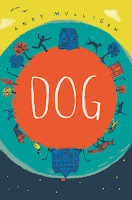It's a wonderful story about eleven-year-old Tom who is having a hard time of it at school. He's also having personal troubles due to the fact his parents have broken up. When his father reluctantly buys him a dog, he couldn't be happier. But the dog, named Spider, has personal issues of his own. When Spider runs away from home, Tom must do all he can to be reunited.
This is a sweet and sensitive story about a boy and his dog, sure to appeal to all readers 9 years and up.
To view the latest edition of the North Melbourne Books newsletter, click here. To sign up for our monthly newsletter, click here.
North Melbourne Books talks to Andy Mulligan
Andy Mulligan: I’m interested in them, I suppose – and work on the assumption that we are all very anxious and very vulnerable most of the time, even if we get extremely good at hiding it. My memory of being a child is that going to a big new school is fraught with worries, and Tom/Spider is undoubtedly a version of me as I jumped to the wrong conclusions, got confused, lashed out, got hurt, sad and happy again. Sometimes we ache to go back to our childhood, but I think that’s usually because we ache to put things right, or have another go and do less damage. Writing DOG was very much about re-visiting anxious times, and remembering the wondrous relief when things turned out to be not as bad as you’d feared!
NMB: The cast of characters in DOG is so varied and vibrant. There's the self-absorbed cat Moonlight, Hilda the goofy fish, Buster the noble yet tough pit bull, Thread the menacing spider, Jesse the fox and Flea, who is of course a flea. How did you come up with all the characters? Did you choose favourite animals and insects to portray?
AM: Not really. I find the characters emerge instinctively as you hit obstacles in the story, or spot opportunities. Naturally, you want contrasts. The pit-bull was inspired by a terrifying poster on a train, inviting me to donate money to a charity that supported fighting dogs - dogs that had been mutilated in dog-fights. The poor creature staring at me looked so brain-damaged and sad I knew she had to come into the novel. As for the flea, I wanted someone strong, straight-forward and honest and loved the idea that something so tiny and despised could be that character. When you’ve spent time with a cruel, manipulative character – such as the spider, Thread – you yearn to balance it with someone as pure as the little moth. Writing DOG was a real joy.
NMB: The theme of the novel seems to be the importance of true friendship, despite the hardships. What does the story mean to you?
AM: It means a lot to me. It’s a love story, for one thing, and the pulse beating throughout is ‘be kind, and value those around you’ – which is hardly a profound thing to say, but it’s probably the most important thing one can ever learn. It’s very hard to sustain kindness, and live up to the standards we aspire to - because we all get distracted, let ourselves down and take advantage of other people. But the book is about people trying to be better. Tom and Spider discover unconditional love, and in the course of their odysseys learn to be a little wiser in the choices they make. ‘It’s a story about friendship’ sounds trite, but that’s exactly what it is. There is nothing more important than the bonds we forge with those around us, and if we can’t accept and value the love that’s offered we’re in for a very grim time. I’m not interested in getting other people to realize that: I’m trying to realize it myself. That doesn’t mean DOG is personal therapy: it means that just like most writers I raid the personal experiences I’ve had, and work through all those things that still torment and fascinate me.
NMB: DOG in some ways is reminiscent of children's books such as Piers Torday's Last Wild series, with its colorful animal characters, and R.J. Palacio's Wonder for its sensitive portrayal of troubled childhood. What children's writers do you count as influences?
AM: I’m afraid I stay away from other children’s writers, for fear of being frozen with envy – and I dread accidentally copying or stealing. So my influences are from a long time ago – Enid Blyton, who told good, quick stories. I love AA Milne for the profundity of such simple-seeming characters and tales, and there’s a truly terrifying book called Marianne Dreams by Catherine Storr that often comes back to me. I read it when I was 10 and it haunted me – I think it made me realize how psychologically powerful books could be. But the great Anthony Buckeridge is always a ghost in my study, too – a beautiful writer of school stories, that still make me cry with laughter. He was the children’s PG Wodehouse. When I’m writing, I always have a Dickens on the go. If I ever get stuck, twenty minutes with Charles unsticks me.
NMB: What books are you enjoying reading at the moment?
AM: I’m re-reading Great Expectations and have just started Monica Ali’s Brick Lane having heard a lovely interview with her.
DOG, by Andy Mulligan. Published by Pushkin Children's. RRP: $19.99
Release date 18th December


No comments:
Post a Comment